A Media Replacement Emergency
Comments Off on A Media Replacement EmergencyMedia replacement is commonly performed on Regenerative Thermal Oxidizers (RTOs) when the media becomes plugged from contaminates in the process stream fed to the RTO. Anguil Environmental Systems frequently replace media in both Anguil manufactured and non-Anguil manufactured systems.
The Challenge
Anguil Environmental Systems recently completed an emergency media replacement on two Megtec Cleanswitch Regenerative Thermal Oxidizers (RTOs) for a world-wide automobile supplier.
The Solution
Both systems were 65,000 SCFM (104,325 Nm3/hr) units and built by another supplier previously for two different automotive facilities in the United States.
Anguil was chosen to replace the RTO media for this world-wide automobile supplier over the original supplier based on our competitive pricing and timely responsiveness.
The Result
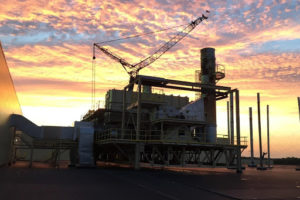
At the other facility where production uptime was critical, Anguil’s crew worked double shifts to complete the work over a weekend so that the production was not affected.
Anguil completed the projects early and under budget due to proper planning and customer communication.
Rubber Curing Emissions
Comments Off on Rubber Curing EmissionsThe Challenge

The Solution
After thorough technical evaluation, the plant selected Anguil Environmental to solve their VOC emission problem and put them in compliance. Anguil installed its patented Self-Cleaning Ceramic Filter (SCCF) to eliminate the blue haze and the VOCs.
 The Result
The Result
In order to alleviate the maintenance headaches of their ESP, the owner inquired about a thermal oxidizer. However, the fuel costs of a thermal system are almost equal to the maintenance cost of an ESP for this application. Because of its fuel efficiency and lower operating costs, the Regenerative Thermal Oxidizer (RTO) was a possible option but Anguil found that the footprint and the weight of the unit could not provide the flexibility the customer desired. Anguil’s engineers concluded that an SCCF was the most effective solution.
One of the major considerations in designing a treatment system for a rubber curing process is that the ducts must be kept clean from any particulate buildup. Large treatment systems, like an ESP or RTO, also involve long duct runs. This combination makes many treatment solutions both costly and dangerous, since particulate buildup can cause duct fires.
Anguil worked with the customer and their process engineers to design a solution that greatly reduced duct maintenance cost and provided effective opacity and VOC control. The small footprint of multiple SCCFs allowed Anguil to roof-mount the units and treat 1,500 SCFM (2,407.5 Nm3/hr) over each of the oven “zones” with direct duct runs. By making shorter and more direct duct runs, Anguil engineers reduced the risk and associated costs of particulate buildup.
Added benefits of the Anguil SCCF include a 40% effective shell and tube heat exchanger, providing even greater cost savings through heat recovery. Anguil’s flexibility also provides options for future adjustments in pollution control. Because the plant was located in an area that may come under more stringent environmental regulations, Anguil’s SCCF can be equipped with catalyst to achieve greater than 95% VOC destruction.
After a successful SCCF pilot, Anguil’s engineers worked with the customer to provide the most effective and lowest-cost operating system. Flexibility, experience and constant pursuit of better design resulted in another satisfied Anguil customer.
World’s Largest Remediation Site
Comments Off on World’s Largest Remediation Site The Challenge
The Challenge
Hong Kong’s Kai Tak Airport was once the world’s busiest airport and eventually became the world’s largest remediation site once it was closed. When the airport was decommissioned, the government planned to rapidly clean up the site for commercial and residential development. After many years of soil penetration by various fuels and chemicals, the site required an extensive and sophisticated groundwater cleanup. The project consultant needed a treatment system that could destroy at least 95% of the volatile organic compounds (VOCs) and minimize operating cost. The project was highly publicized and generated intense government and public interest therefore the chosen treatment system had to be proven and reliable.
The Solution
After an extensive evaluation of various VOC treatment solutions the consultant selected an abatement system from Global Technologies, the remediation division of Anguil Environmental. Global’s extensive engineering support and industry-leading reliability, and its history of solving difficult remediation problems around the world, made Global the obvious choice. Global engineers performed a careful evaluation of the application data and recommended a Model 80 Remedi-Cat TM forced draft system. The system processes 8,000 SCFM (12,616 Nm3/hr) of VOC-laden air and provides at least 95% destruction rate efficiency.
 The Result
The Result
Global Technologies’ experience with processing large air flows and varying organic loading was crucial to this project. The proven performance of Global treatment systems provided the Kai Tak project engineers the confidence to design an innovative remediation plan. Global’s vapor treatment system was designed to be the heart of this cleanup strategy.
To aggressively remove the subsurface contaminants, the engineers blanketed the old airport tarmac with 2,000 soil vapor extraction (SVE) wells and 1,000 sparge wells.
The massive airflow was directed from the wells to a single treatment system. Compared to a modular approach that would require more treatment systems to treat a limited number of wells, this strategy provided significant savings in energy, fuel and personnel. Global was up to the challenge; their experience designing oxidation systems for some of the world’s most difficult remediation sites led to an advanced vapor treatment system for Kai Tak.
Global selected a catalyst that utilizes a honeycomb construction to provide superior airflow and low pressure drop. The catalyst selected has undergone extensive technical development and field-testing and was chosen to accommodate the unique airflow volume, the amount and type of VOC, and the desired destruction efficiency of the Kai Tak project.
Another key design feature of Global’s vapor treatment system was the variable frequency drive (VFD). The VFD controls the speed of the system fan, regulating airflow through the system and allowing the oxidizer to handle efficiently the air volume fluctuations from the 2,000-plus extraction wells. With a maximum turndown ratio of 10:1, the VFD can produce energy savings far superior to an inlet vane damper. Global provided the VFD with a particulate filter and housed it in a NEMA 4 enclosure to protect it from the sun and other elements.
Like all Global Technologies’ systems, the Model 80 Remedi-CatTM was manufactured with the highest quality workmanship and materials of construction. The heat exchanger and reactor were constructed of 304L stainless steel with continuous, leak-tested welding around all seams. To withstand the natural elements, the exterior shell was constructed of aluminized steel with a coat of UV resistant polyurethane paint. High-density mineral wool was placed between the inner and outer shells to maintain external skin temperatures at safe levels.
A final significant consideration was worker and equipment safety, which is a major concern for every Global Technologies system and especially important on a high profile project like Kai Tak. With safety in mind, Global has developed a state-of-the-art Programmable Logic Controller (PLC) which allows safe and intelligent operation with minimum risk. The PLC provides immediate troubleshooting, first-out shutdown detection and operator assistance for start-up. Global’s built-in, user-friendly features provide the on-site operators more control, increased up-time, and reduced maintenance costs.
Global Technologies’ understanding of a customer’s unique needs, coupled with the engineering know-how necessary to fulfill these needs, resulted in another satisfied Global customer. The cost-saving strategy of controlling numerous wells with one treatment system was made possible by Global’s ability to accommodate the large and varied airflow from the wells. Global’s aggressive and innovative treatment strategies are helping Kai Tak Airport move into a cleaner and safer 21st century.
Pemaco Superfund Site Remediation
Comments Off on Pemaco Superfund Site Remediation The Challenge
The Challenge
Pemaco was formerly a chemical facility located in a light industrial and residential area of Maywood, CA, adjacent to the Los Angeles River. No one knows how long hazardous substances had been leaking into the ground but the operations date back to the 1940’s. Up until closure of the facility in 1991, chlorinated solvents, aromatic solvents, and flammable liquids had all been used in the chemical mixing, blending, storage and distribution processes at this location.
After a fire at the abandoned Pemaco location, the Environmental Protection Agency (EPA) was called in to stabilize the site and conduct an emergency assessment to determine the extent of contamination into the soil and groundwater.
The EPA worked with several environmental consultants to define a detailed remediation plan for the superfund site. It was determined that solvents and other compounds from tanks and drums caused soil contamination deeper than 90 feet. A 14-acre groundwater plume that migrated into a complex aquifer system under residential properties threatened local water supply wells with Perchloroethylene (PCE), Trichloroethylene (TCE), Trichloroethane (TCA), Dichloroethane (DCA) and Vinyl Chloride (VC).
The Solution
The remediation technologies used would include Electrical Resistance Heating (ERH), Soil Vapor Extraction (SVE), thermal oxidation, acid gas scrubbing and carbon absorption. The goal was to completely remediate the 1.4-acre site of these Volatile Organic Compounds (VOCs) and redevelop it as a public park. The vapor treatment portion of the project combined ceramic core flameless thermal oxidation (FTO) with acid gas scrubbing, vapor conditioning, and a carbon adsorption polishing step to control potential dioxin emissions.
 The Result
The Result
Working with several environmental engineering firms and the US Army Corp of Engineers, Global Technologies supplied a 1,000 SCFM (1,605 Nm3/hr) Flameless Direct Fired Thermal Oxidizer (DFTO) with a caustic scrubber for emission treatment from the SVE units. The vapor treatment system was designed to handle typical averages of 315 parts per million (ppm) but capable of maximum spikes up to 25,000 ppm.
The oxidizer was designed to achieve 99.9% destruction of hydrocarbons with a unique gas-fired burner that generates virtually no nitrogen compounds (NOX) during combustion. The patented surface combustion technology ensures that all emissions are exposed to the high temperature zone only along the innermost surface. Another important advantage of this arrangement is that hot combustion gases are completely contained within the burner and the oxidizer outer shell remains cool. Therefore the flameless oxidizer can be processing toxins in a matter of seconds after ignition.
A gas flow control valve was integrated to reduce operating costs. By reducing gas flow as the energy content of the VOCs increases the oxidizer uses less supplemental fuel for combustion. It operates in response to control signals from a thermocouple located immediately downstream of the oxidizer burner.
Downstream of the oxidizer, exhaust gases flow into the integral scrubber quench chamber via Fiberglass Reinforced Polymer (FRP) ducting. Adjacent to the oxidizer, the skid mounted scrubber uses polypropylene packing to treat the acid gases. It was optimized to reduce the water usage without sacrificing spray coverage and the design allowed for a max HCl loading of 472 lbs/hr.
The flameless DFTO and scrubber were arranged in an induced draft configuration, pulling exhaust through the system and keeping it under negative pressure to prevent the escape of any corrosive gases.
The United States EPA filmed a documentary about the Pemaco remedial action for internal training purposes. The documentary highlights several “firsts” for the EPA including the use of a flameless thermal oxidizer for vapor treatment. More information can be found on the EPA website.
Mobile Remediation System
Comments Off on Mobile Remediation System The Challenge
The Challenge
A large consulting and contracting firm owns and operates several ex-situ Thermal Desorption Units (TDUs). Each single-load unit has the capacity to desorb 15 tons of soil per hour at a temperature of 400°F – 900°F (204°C – 482°C). These TDUs have been designed to operate on both chlorinated and non-chlorinated contaminants. They are also approved for use under the Resource Conservation and Recovery Act (RCRA) and Comprehensive Environmental Response, Compensation and Liability Act (CERCLA) as well as private industry sites. Since each TDU has the flexibility to operate on standard hydrocarbon and halogenated hydrocarbon applications, the selected pollution control system has to share this flexibility. Due to varying environmental regulations throughout the country on Hydrogen Chloride (HCL), the selected pollution control system also had to eliminate any HCL generated by the oxidation of chlorinated compounds. Finally, the control systems portability was a crucial factor since this contractor’s profitability is based upon how quickly the system can be mobilized, operated and then demobilized for movement to the next site.
The Solution
The lack of inexpensive natural gas feeds at many of these sites dictated the use of propane as a fuel source for the oxidation technology. Because thermal oxidation requires operating temperatures between 1600°F – 2000°F (871.1°C – 1093.3°C) , the customer was concerned that this technology would lead to unacceptable fuel and operating costs. After examining various capital equipment options and the corresponding operational costs, the consulting engineer recognized the benefits of a catalytic oxidizer which operates at much lower combustion temperatures. After a thorough technical evaluation and bid process, Global Technologies was selected to solve their VOC problem by providing a mobile treatment package, complete with a Chlorinated Catalytic Oxidizer (Chloro-Cat TM) and HCL scrubber package.
The Result
Global’s experience with chlorinated catalytic oxidation and HCL treatment prior to the initiation of this project was extensive. At this point, Global had installed over 30 such systems to treat chlorinated streams from Soil Vapor Extraction (SVE) and airstripper sites. This experience proved invaluable in designing and implementing the proper solution. Each rotary kiln or TDU could be expected to exhaust up to 5,000 SCFM (8,025 Nm3/hr) of desorption air at a temperature between 400°F – 900°F (204°C – 482°C) and a chlorinated VOC concentration of 3,000 ppmv. Utilization of a high-temperature baghouse dust collector on the TDU skid removed concerns associated with dust or dirt plugging of the monolithic catalyst cells.
Global utilized an induced draft FRP fan on the back end of the treatment package due to the high temperature, highly saturated exhaust from the TDU. As with all Global chlorinated catalytic systems, a 316L stainless steel shell and tube heat exchanger was installed in the 316L stainless steel reactor. The chlorinated catalytic system was designed to provide 99% destruction efficiency at a temperature of 500°F – 850°F (260°C – 454°C) to reduce auxiliary fuel usage. Safety systems were installed to ensure no HCL condensation or system corrosion.
The 50′ drop deck trailer, upon which the chlorinated system was mounted, also incorporated a Liquid Propane Vaporizer, a storage area for equipment transport, and an HCL Scrubber capable of 99.9% HCL removal in both caustic and pure water mode.
The most recent compliance testing of this turnkey package demonstrated over 99% destruction of all compounds. The result is another satisfied Anguil client.
Chlorinated Groundwater Treatment
Comments Off on Chlorinated Groundwater Treatment The Challenge
The Challenge
A Fortune 50 company implemented a remediation system to collect and treat polluted groundwater from a site in Central New York and prevent impacted groundwater from flowing into local waterways. An engineering and construction firm (EPC) was hired to design and build an effective, efficient groundwater treatment system. Primary treatment of the polluted water was to be accomplished using air strippers and the effluent then sent to a separate offsite facility for final treatment. The VOCs liberated from the groundwater by the air strippers, including benzene, chlorobenzene and dichlorobenzene, require treatment before being released to the atmosphere.
The design-builder required an air pollution control system which could destroy 99% of the VOCs and safely remove any of the resultant inorganic acid gasses that would be formed. As this was a long-term project, the VOC control system needed to be highly reliable and provide low operational costs.
The Solution
After a thorough evaluation, the design-build consultant selected Anguil to provide the VOC treatment solution. Anguil’s extensive engineering support, industry-leading reliability, and history of solving difficult halogenated destruction problems around the world made them the obvious choice. Anguil engineers recommended a Model 50 Regenerative Thermal Oxidizer (RTO) with an Acid Gas Scrubber. The system is capable of processing up to 5,000 SCFM (8,025 Nm3/hr) of VOC-laden air while providing 99% VOC destruction efficiency and 99% removal by weight of Hydrochloric Acid.
The Result
Anguil’s engineering resources and experience processing halogenated contaminants were crucial to this project. In the Anguil two chamber RTO, polluted air is preheated as it passes over ceramic media beds located in the energy recovery chamber. From there, the process air moves into the combustion chamber where the Volatile Organic Compounds (VOC) are oxidized. Heat from the hot air stream is then recovered by the second ceramic media bed before being exhausted to the acid gas scrubber. A flow diverter poppet valve switches the airflow direction so both energy recovery beds are fully utilized, thereby reducing the auxiliary fuel requirement as much as possible. Anguil’s two chamber RTO is designed to achieve a heat recovery of 95% TER and results in significantly lower operating costs than other thermal oxidation technologies.
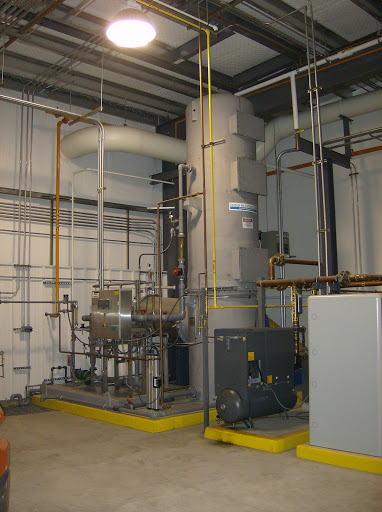
The specified vapor treatment system included several design features that ensure safe and effective operation in the expected environment. First, an induced draft arrangement was utilized where the process fan is located downstream of the scrubber. An induced draft arrangement is preferred for halogenated applications because it creates a negative air pressure through the entire system where acid gasses are present, minimizing the potential leaking of corrosive gasses which can be forced out of a system under positive pressure. Leakage of s corrosive acid vapors produced by the RTO from the oxidation of halogenated hydrocarbons from equipment connections and penetrations y can corrode the outer shell of the equipment and surrounding environment, as well as posing human health and safety concerns.
Special consideration was given to the materials of construction to ensure performance and reliability in the corrosive environment. Upgraded materials of construction selected for key areas of the RTO are field-proven from Anguil’s many halogenated installations. For example, RTO outer reactor shells were constructed of carbon steel but internally coated with a specialty coating to resist hydrochloric acid corrosion from the inside out. Poppet valves were fabricated from a high nickel alloy, while transitions from the RTO outlet plenum and the acid gas scrubber quench were constructed of hastelloy. The scrubber tower, sump and stack were all fabricated out of FRP (Fiberglass Reinforced Plastic).
Equipment location at the facility was carefully selected to reduce installation costs and minimize equipment downtime. The scrubber was installed inside the treatment building, eliminating the concern of freezing during cold months and costs associated with winterization. The oxidizer was placed outdoors adjacent to the treatment building and near the scrubber system to eliminate extensive ductwork runs.
Anguil’s understanding of the customer’s unique requirements and engineering knowledge of the detailed process conditions resulted in an efficient and reliable system and ultimately another satisfied Anguil customer.
Flexographic Printer: Efficient Emissions
Comments Off on Flexographic Printer: Efficient Emissions The Challenge
The Challenge
Control of air emissions has become an important issue that flexible packaging converters must consider when changing or upgrading equipment. A producer of printed shrink films, bags and pouches for a diverse range of applications addressed its emissions in 1991 and 1996 by investing in two Anguil catalytic oxidizers to control the EPA-regulated air emissions generated in their various processes.
But when the company decided to purchase a new 10-color gearless press to increase capacity and capability years later, management knew they also needed to determine if an alternate technology would reduce their operational costs compared to their two catalytic oxidizers.
The Solution
Having supplied the original catalytic oxidizers, the customer contacted Anguil Environmental to analyze the most cost-effective and compliant way to replace the two aged systems. After an analysis, Anguil recommended replacement of the existing equipment with a single 25,000 Regenerative Thermal Oxidizer (RTO).
The Result
RTOs Replace Catalytic Oxidizers
Though the catalytic units were a logical choice at the time of purchase, technological advances in the ensuing years had caused the RTO to become a much more viable abatement strategy.
Now 15-20 years following the original catalytic oxidizer installations, the customer and Anguil’s objectives were to:
- Achieve destruction of 98 percent of the Volatile Organic Compounds (VOCs) in the press exhaust
- Fit the system into limited space
- Complete the tear-out and subsequent installation in just six days
The operation of the RTO is considerably different from the existing catalytic units. The oxidizer consists of two reinforced, insulated chambers filled with high temperature structured ceramic energy recovery media. The oxidizer utilizes a burner to maintain the oxidation temperature. Located beside the energy recovery chambers are diverter valves and air duct plenum passages, which allow the press exhaust to be diverted into and out of the oxidizer in either a clockwise or counterclockwise mode. The directional mode is controlled by a PLC, which changes the direction of airflow at regular intervals to optimize system efficiency.
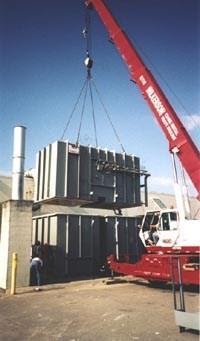
In operation, solvent laden air (SLA) enters the oxidizer via an energy recovery chamber where the high temperature ceramic heat transfer media preheats the SLA prior to introduction into the oxidation chamber. As the SLA passes up through the bed, its temperature rapidly increases. After the chemical oxidation purification reaction occurs, the hot, clean, outgoing gas heats the exit energy recovery bed. In order to maintain optimum heat recovery efficiency, the SLA flow direction is switched at regular intervals by the automatic diverter valves on demand from the PLC control system. This periodic flow direction shift provided a high thermal efficiency to minimize customer operational cost.
With sufficient concentration of hydrocarbons in the process air stream, the heat energy content of the VOCs will result in self-sustained operation with no auxiliary fuel usage.
Features that are specific to the RTO include:
- High volumetric turn-down capability, enabling the control of multiple presses and the reduction of operating cost.
- Thermal energy recovery of 95 percent or higher, allowing self-sustaining operation with no auxiliary fuel usage at levels as low VOC exhaust concentrations..
- Customized thermal energy recovery media, providing low-pressure drop and low electrical cost.
Anguil’s vast experience, gained after supplying more than 2,000 successful systems around the world, provided the confidence necessary for this customer to choose Anguil as their continued VOC control supplier for three decades and counting. Anguil was able to modify its standard RTO design to fit into the space provided and to execute tear-out and new installation within a short timeline. The result was a system that exceeded the 98 percent destruction efficiency objective while lowering operating cost by more than 60 percent.
Converter Finds Affordable Compliance Solution
Comments Off on Converter Finds Affordable Compliance Solution The Challenge
The Challenge
It’s not just about increasing production for Fredman Bag’s president, Tim Fredman Jr., it’s also about being an environmentally conscious neighbor. A converter’s decision to expand their capacity is often made more complicated by a corresponding need to invest in air pollution control equipment. Recent expansions had Fredman Bag making major investments in their air pollution control equipment not only to meet EPA (Environment Protection Agency) regulations but also keep their reputation as a good neighbor.
The Solution
Fredman Bag, a Milwaukee-based flexible packaging converter purchased a new, eight-color, gearless CI-flexo press from Uteco Converting to adapt to their customer’s growing needs, enhancing their product offering and delivery capabilities. The gearless-press runs at faster speeds with a higher resolution, printing a superior-quality product and increasing production for Fredman Bag by nearly 40%.
The VOCs (Volatile Organic Compounds) and HAPs (Hazardous Air Pollutants) emitted by a printing press are not only harmful to the environment but also people who breathe them. Fredman Bag had been using an Anguil 6,000 SCFM (9,630 Nm3/hr) catalytic oxidizer as an effective means of air pollution control before their expansion but the increase in emissions and flow from the new press was beyond the capacity of the existing 10-year old oxidizer. After serious consideration, Fredman again turned to Anguil Environmental Systems, also a Milwaukee based firm, to address their pollution control needs.
 The Result
The Result
Anguil’s application-specific engineering, stressing air volume reduction, energy-efficiency and improved emissions capture provides an affordable and flexible solution. Taking into consideration future growth, a 12,000 SCFM (19,260 Nm3/hr) Regenerative Thermal Oxidizer (RTO) was selected to ensure regulatory compliance. The Anguil RTO technology provides significant operating cost savings.
The Anguil two-chamber RTO heats exhaust air from the printing presses as it passes through beds of ceramic media located in an energy recovery chamber. The process air moves from the recovery chamber toward the combustion chamber, where the VOCs are oxidized, releasing energy into the second energy recovery chamber. A diverter valve switches the airflow direction so both energy recovery beds alternately store and release energy to minimize operating costs by reducing any auxiliary fuel requirement. This system is designed for heat recovery of over 95% and is self-sustaining, requiring little if any auxiliary fuel even with low VOC loadings. This energy-efficient recovery means the Anguil RTO offers lower operating costs over other emission treatment methods. As a result of Fredman’s decision to use the energy-efficient Anguil oxidizer, the company was eligible for Wisconsin Energy’s, Focus on Energy program. The incentives they received allowed them to go ahead with the project sooner than they had initially hoped.
Lost production was another concern for Tim Fredman, Jr. Air pollution control equipment doesn’t increase a manufacturer’s bottom dollar like other capital equipment does but it can often cost them significantly in downtime. Anguil took careful measures to assure that there were no disruptions in Fredman’s process. By utilizing existing ductwork, preparing accordingly and coordinating with the customer, Anguil was able to install the complete system in under three days. The oxidizer was delivered to Fredman Bag on a Thursday during a scheduled maintenance shutdown, installation was complete by Saturday and start-up was done that same day, saving the converter any lost production.
The Anguil system can be monitored and controlled 24/7 from remote locations for ease of troubleshooting and adjustments, eliminating unnecessary service calls. It has a high volumetric turndown capacity to minimize operating costs during process idle, downtime or on weekends. The Anguil oxidizer has been operating, maintenance free at 99% destruction rate efficiency since start-up. A trouble free air pollution control system allows Tim Fredman Jr. to concentrate on production and sales, knowing his company is in compliance.
RTOs Leave Nothing Hap-Penstance
Comments Off on RTOs Leave Nothing Hap-Penstance The Challenge
The Challenge
The United States EPA promulgated a ruling in 40 CFR, imposing strict new standards to reduce emissions of toxic air pollutants from the manufacture of pharmaceutical products, including prescription and over-the-counter drugs. The agency’s rule was intended to reduce emissions of a number of air toxins and hazardous air pollutants (HAPs), including methylene chloride, methanol, toluene and HCI. It was estimated at the time that the ruling would reduce air toxins annually by approximately 24,000 tons or 65 percent from contemporaneous levels. The affected pharmaceutical manufacturing processes included chemical synthesis (drawing a drug’s active ingredient) and chemical formulation (producing a drug in its final form).
The Solution
One of the approximately 100 facilities affected by the ruling was a pharmaceutical plant in upstate New York. Determined to stay below acceptable MACT levels, the company set out to establish compliance needs and subsequent direction by contracting with a consultant to formulate a compliance plan. The result was a specification package that required oxidation and caustic scrubber technologies.
 The Result
The Result
Specifically, the design included a primary and backup system, each consisting of two 35,000 SCFM (56,175 Nm3/hr) regenerative thermal oxidizers (RTOs) and two 35,000 SCFM (56,175 Nm3/hr) caustic scrubber systems. The RTOs were to process the emissions, including methylene chloride, acetone, ethanol, isopropyl, alcohol, methanol and mineral spirits, and were designed to achieve over 99-percent destruction efficiency. The scrubbers were designed to process treated gases and achieve 99.5-percent reduction of the HCI derived from the oxidation process. After the design phase, the two technologies were selected in order to oxidize the VOC/HAP compounds, and to remove the resultant HCI emissions from the outlet of the oxidizer. Upon receipt of the specification package, the engineering staff at Anguil began to design the system within the boundaries of the specifications.
The specification package included the following requirements and parameters:
Process producing emissions – multiple (~60) sources including:
- Conservation vents
- Reactor vents
RTO materials of construction:
- Refractory selection: The RTO included the installation of high-purity ceramic fiber insulation, because of its resistance to HCI attack.
- Purification chamber outer skin: The purification chamber was constructed of 0.25 inch A36 Steel. It was internally blasted and coated with a vinyl ester corrosion-resistant coating. This coating resists any HCI (vapors or condensed acid) that could potentially reach the RTO shell behind the insulation. The coatings were pigmented so that the first coating was light gray and the second coat was dark gray. This allowed a visual inspection to identify that the coating was thoroughly applied during fabrication, and provides an easy means of checking for coating degradation after operation.
- Ceramic media support grid: The ceramic media support grid was constructed from Hastelloy C276 in order to support the ceramic media. This “cold face” has the potential too see condensed acid gas. Hastelloy C276 provides high strength and resists both chloride stress corrosion cracking and chloride pitting and crevice corrosion.
- Inlet plenum: The inlet plenum is the duct located underneath the RTO that connects to the three inlet butterfly diverter valves. The air flowing through this duct to the RTO contains VOCs and HAPs but does not contain acid gases. However, as a precaution against corrosion, this ductwork was constructed of AL-6XN, a corrosion resistant alloy.
- Outlet plenum: The outlet plenum is the duct located underneath the RTO that connects to the three outlet butterfly diverter valves. The air flowing through this duct to the RTO contains acid gases. This ductwork was constructed of Hastelloy C276.
- Bed/plenum/hopper: The plenum beneath each of the three ceramic media support grids was constructed of Hastelloy C276.
- Butterfly valves (bed inlet, outlet and purge): The three inlet diverter valves process air containing VOCs and HAPs. The three outlet diverter valves contain air containing acid gas. All sic valves were constructed of Hastelloy C276. The three purge valves were also constructed of Hastelloy C276.
- Transition to acid gas scrubber quench: The transition from the RTO outlet plenum to the acid gas scrubber quench contains acid gases. This ductwork was also constructed of Hastelloy C276.
Floor sweeps:
- Waste stream flow rate: 6,500-35,000 SCFM (10,432.5-56,175 Nm3/hr)
- Waste stream temperature: 50 to 100ºF
- VOC/HAP breakdown
The company possessed a long history treating halogenated compounds, including oxidation and acid gas scrubbing equipment. The two RTO and scrubber systems supplied here were actually installed after a smaller oxidizer and scrubber was operational within the same facility.
General Operational Description
Designing the oxidizer first, engineers specified that each RTO would process up to 35,000 SCFM (56,175 Nm3/hr) of VOC/HAP-laden air, providing 99.5% destruction efficiency.
Pharmaceutical Industry Pollution Control Solutions
The oxidizer consisted of three reinforced, insulated, steel chambers filled with high-temperature, structured ceramic energy recovery media. Each oxidizer would utilize two burners to maintain its oxidation temperature set-point, and provide even temperature distribution within the combustion chamber for maximum VOC/HAP destruction. Located below each of the energy recovery chambers would be inlet and outlet diverter valves and the associated air duct plenum passages. These would allow the process airflow to be diverted into and out of each of the heat recovery chambers. One duct would act as an inlet to the energy recovery chamber, the other as an outlet from the chambers to the acid gas scrubber. A third, smaller duct would direct heated purge air to each chamber. A purge valve for each chamber would control the flow of purge air into the chamber. The directional mode and purging would be controlled by a PLC program, which would change the direction of airflow at regular intervals to optimize system efficiency. The typical flow directions within the RTO would be adjusted every 90 seconds.
In operation, solvent-laden air (SLA) would enter the oxidizer via an energy recovery chamber, where the high-temperature ceramic heat transfer media would rapidly preheat it prior to its introduction into the oxidation chamber. After the chemical oxidation purification reaction occurs, the hot, clean, outgoing gas would heat the exit energy recovery chamber.
The SLA flow direction would be switched at regular intervals to maintain optimum heat recovery efficiency by the automatic diverter valves on demand from the PLC control system. After serving as an inlet, an energy recovery chamber would be purged for a cycle before serving as an outlet. This ensured that all air that entered a bed would be treated to the maximum extent possible. With sufficient concentration of hydrocarbons would self-sustain the oxidation process. The oxidizer can be operated in an off-line bake-out mode to allow the removal of organic buildup on the heat exchange media. The potential organic material consists of methylcellulose and lactose. In the bake-out mode, the RTO/scrubber trains are taken offline from the process. At a reduced airflow, the outlet temperature is allowed to rise before the flow direction is switched. This hot air vaporizes organic particulate collected on the cold face of the heat exchange media. The flow direction is switched and other cold faces are cleaned in succession.
Process Air Flow
Two 35,000 SCFM (56,175 Nm3/hr) systems were specified to provide redundancy while processing flows from 6,500 SCFM (10,432.5 Nm3/hr) to 35,000 SCFM (56,175 Nm3/hr). Each RTO/scrubber train would be functionally equivalent and operate in conjunction with or independent of each other. Each system could be returned down 6:1 (5,850 SCFM, 9,389.25 Nm3/hr). If the airflow to an individual RTO/scrubber was reduced below this level, a pressure control loop could open the fresh air damper to maintain the minimum system airflow. Butterfly isolation dampers were included at the inlet and outlet of each RTO/scrubber. The inlet isolation damper would be used to isolate an RTO/scrubber train during startup and shutdown. The outlet isolation damper would be activated when the RTO/scrubber was not in use. Butterfly isolation valves were included downstream of the scrubber; the manually operated valves would be used to isolate the RTO/scrubber train for service. A flanged blind was also included for installation downstream of the scrubber for isolation during service.
Fan Location
The RTO processes corrosive HCI vapors as the chlorinated hydrocarbons are oxidized. In a forced draft arrangement, the RTO is under positive pressure. In that configuration, the corrosive gases will tend to leak to atmosphere at the instrumentation (thermocouple) penetrations and the corrosive gases will condense at this interface corroding the outer shell. Therefore, an induced draft arrangement is typically preferred for chlorinated RTO applications. A fan was designed for the conditions at the scrubber outlet, including a radial blade fan wheel constructed of a corrosion resistant alloy, Hastelloy C276, and a carbon steel housing lined with rubber. This type of fan wheel was not as efficient as backward inclined or air foil designs, but it would not be as sensitive to aerosol droplets and offered a lower tip speed, reducing fan noise.
99.5% Destruction Efficiency Design
A residence time of two seconds at 1650°F was proposed to achieve an average destruction efficiency of 99.5 percent. Actual compliance test data demonstrated destruction efficiency in excess of 99.9 percent. In order to guarantee the high destruction efficiency that this project required, additional steps were taken to reduce the air not fully treated when the airflow changed direction. For the 99.5-percent destruction guarantee, the system was designed with three chambers. At any one time, one chamber would act as an inlet and one as an outlet, while the third was being purged. After serving as an inlet chamber, each chamber would be purged with heated clean air during the next cycle. The purge air would be heated to minimize the potential for HCI gas water vapor condensation and the resultant corrosion potential, even though high nickel and molybdenum alloys were used to resist corrosive effects. It would then become an outlet chamber during the next cycle. The three-chamber design also minimized any inlet/outlet bypass during valve cycling.
Acid Gas Scrubber
The acid gas scrubber was designed to process the maximum exhaust capacity of the RTO exhaust, including the purge air containing HCI vapor, providing 99.5-percent HCI removal. The horizontal quench was designed to cool the RTO exhaust to approximately 150°F. The re-circulation pumps provided water into the adiabatic quench through three separate spray headers. The air temperature was reduced to 150°F at the quench outlet. The water that was not evaporated flowed to the recycle sump. Approximately 50 percent of the HCI was scrubbed in the scrubber quench. The air left the horizontal quench and entered the bottom of a counter-current packed tower scrubber. Water and caustic solution was sprayed on the top of the tower. The remaining acid gases were absorbed by the solution as the air passed up the column. The air passed through a mist eliminator to remove entrained water before exiting the scrubber column. A sodium hydroxide solution was added to the re-circulating water to neutralize the adsorbed HCI and form sodium chloride (salt water), the sodium hydroxide addition rate controlled by pH analyzer. Salt water blow-down was controlled by a conductivity analyzer and by adding makeup water, causing sump overflow. The company worked closely with the customer and the consultant throughout the bid process, suggesting options and clarifying details on this major environmental project, and was also commissioned to install the systems. A tight site location necessitated the careful use of over-sized cranes so as to ensure no interference with or rupture of critical plant gas, air and nitrogen lines. Heavy rains throughout much of the process further complicated installation but ultimately the installation of all the equipment and the tie-in of the ductwork, electric and controls, without affecting process, were achieved. The result was a system, which surpassed the customer’s objective of 99.5 percent destruction efficiency and ensured compliance with the EPA’s pharmaceutical MACT.
EtO Sterilizer Abatement
Comments Off on EtO Sterilizer Abatement The Challenge
The Challenge
Product sterilization companies are generally required to utilize a pollution control device, often referred to as an abator, for treatment of exhaust gases from their aeration rooms, sterilization chambers and vessels. In the United States, they need to be in compliance with NESHAP (National Emission Standards for Hazardous Air Pollutants) regulations that dictate a 99% destruction efficiency of EtO (Ethylene Oxide), or concentration levels below one part-per-million by volume.
One contract sterilization company was using a wet scrubbing system that was no longer a viable means of EtO removal. To further complicate the situation, their high production levels meant they could not afford a factory shutdown in excess of eighteen hours. This time limitation made the procurement of a pre-tested, pre-assembled pollution control system a necessity.
The Solution
After examining various technology alternatives and multiple suppliers, the sterilization company chose Anguil Environmental Systems to provide a catalytic oxidizer that would result in NESHAP compliance and minimal downtime.
A back-vent and peak shaver were also considered upstream of the oxidizer to prevent emission spikes from causing an upset condition. However, a detailed application analysis showed it was not necessary on this particular application.
The Result
Having experience with ethylene oxide emissions and sterilizer applications, Anguil recognized several unique challenges associated with this project. First, the catalytic oxidizer had to control both the high concentration, low air volume exhaust from the sterilization chamber’s vacuum pump, as well as the low concentration, high volume exhaust from the aeration room. The high concentration from the vacuum pumps of nearly 300,000 parts per million by volume caused a sharp temperature increase, and demanded that the catalyst have a large operational temperature window. At the same time, the catalyst needed a low operational temperature when treating the low concentration exhaust (10 parts per million by volume) from the aeration chamber.
To satisfy both these needs, Anguil, in conjunction with their catalyst supplier, performed extensive research and was able to supply a base metal type catalyst with an operational temperature of 275°F and an operational temperature window of over 500°F.
On some sterilizer installations, the highly concentrated chamber emissions present another set of challenges. Because they generally come in spikes when the chamber is evacuated, Anguil often recommends and installs a peak shaver or wet-scrubber upstream of the oxidizer as a safety precaution. Safety is always a priority on Anguil oxidizers. This buffer before the combustion device alleviates any concerns of property damage or personal injury.
The next challenge Anguil faced for this application was designing and building a system that not only met NESHAP regulations, but would also operate cost-efficiently. Due to stringent ethylene oxide regulations, catalyst bed bypassing had to be completely avoided. To facilitate this, Anguil altered their traditional design and placed the base metal catalyst in horizontal tray configurations. This minimized the bypassing concerns associated with air passing around the catalyst media or bed.
To keep operating costs down and prevent leakage that could result in a comingling of the clean and dirty air streams, a 65% effective 304L stainless steel leak-and-dye tested shell and tube heat exchanger was used in the oxidizer. Unlike other manufacturers who recommended a plate type heat exchanger, Anguil was able to guarantee 0% leakage of VOC-laden air into the clean air stream. As a fail-safe, Anguil installed an induced draft fan on the catalytic oxidation system. By placing the fan on the discharge side of the oxidizer rather than placing it on the inlet side, the system was under a continuous negative pressure. This meant that any leakage associated with the oxidation system would be released back into the system, rather than out into the work environment.
The entire interior reactor of the oxidizer was constructed of 304L stainless steel, surrounded by mineral wool insulation and an outer aluminized steel frame. This unique design offers multiple benefits, including increased equipment life compared to the industry-standard aluminized steel reactor interior. Another accommodation Anguil had to consider was the customer’s time restrictions due to high production levels. Anguil’s solution was to completely pre-assemble, pre-wire and pre-test the system prior to shipment. The customer’s 18-hour time restriction was met with time to spare.

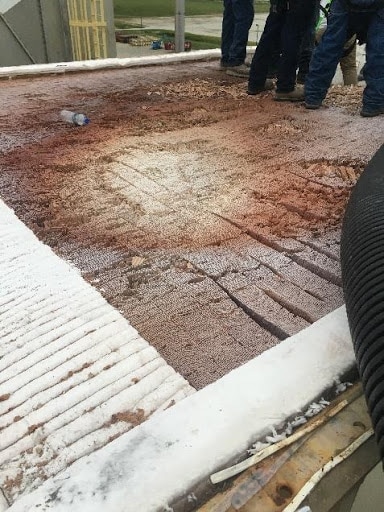
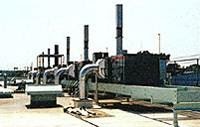 The Result
The Result The Challenge
The Challenge The Result
The Result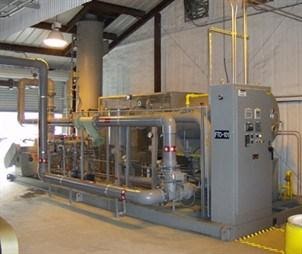 The Challenge
The Challenge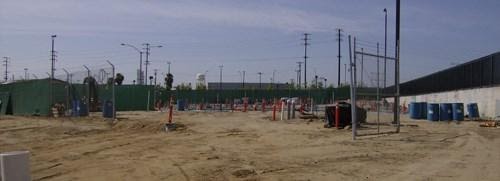 The Result
The Result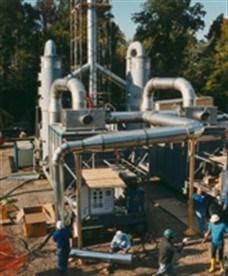 The Challenge
The Challenge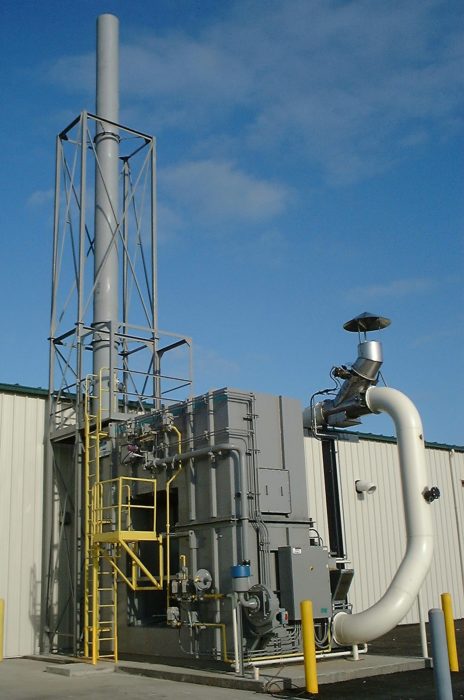 The Challenge
The Challenge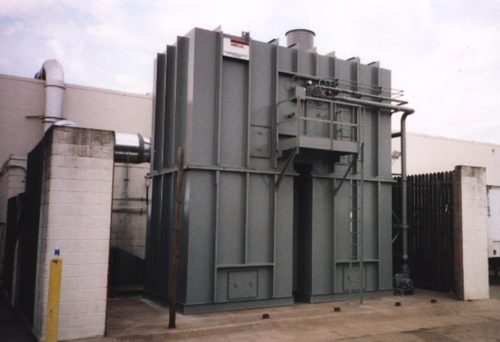 The Challenge
The Challenge The Challenge
The Challenge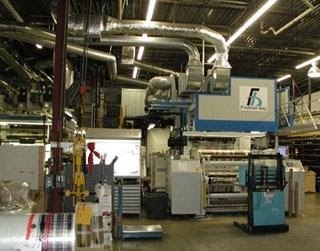 The Result
The Result The Challenge
The Challenge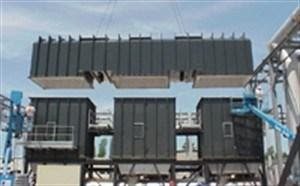 The Result
The Result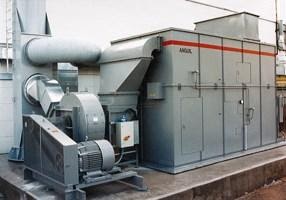 The Challenge
The Challenge